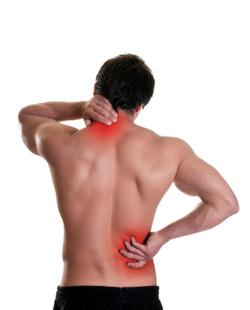 As a massage therapist and yoga teacher I am asked a lot about the best way to treat chronic muscular pain, particularly back pain. Some people don't see the value in stretching or just can't see themselves following a stretch routine, others don't see the value of massage therapy as a long term solution to their problems given the time and costs involved. The truth is that if you are living with chronic pain due to muscle spasm, chronic hypertonicity (excessive muscle tone or tightness) or as a result of soft tissue trauma, then a combination of these two may possibly be the most effective treatment. Yoga vs. Massage for tight muscle tissue There are very specific differences between massage and stretching and both have been proven time and again through clinical trials to be effective in lengthening (reducing hypertonicity in) muscle tissue. If you are currently in pain with restricted range of motion then a course of therapeutic massage will be far better than a yoga class to begin with. While stretching lengthens contracted muscle tissue it can only do so in the direction of the muscle fibres. This means that adhesions or scar tissue which may be contributing to pain and which may not be formed in the direction of the muscle fibre will not be affected by your stretches. Deep Tissue Cross-Fibre Massage Therapy Initial massage therapy work, particularly deep Tuina work, Soft Tissue Release or Myofascial Release techniques will work cross-fibre, stretching the contracted tissue not only from origin to insertion of the muscle, but also separating the fibres as the massage strokes work from one side of the muscle to the other. Both are good? So which do I get first? Once adhesions and scar tissue have been worked out this way, allowing for safer pain free stretching of muscle tissue to occur, it is important to learn how to stretch to maintain and improve the length in the tissue and prevent future injury. So if you are in pain, get the massage or first, follow up with the yoga stretches afterwards. It couldn't simpler (or more enjoyable)!
5 Comments
British Medical Association Recommends Acupuncture
After a two year study the BMA’s board of Science and Education recommended the use of Acupuncture for the treament of conditions including nausea, vomiting, back pain, dental pain and migraine headaches. See the article in the British Medical Journal here. As a practicing acupuncturist I am often confronted with scepticism about the benefits and effectiveness of acupuncture therapy. This no longer surprises me as despite being used for nearly 200 years in Western Europe, still the general level of knowledge about the scientific underpinnings of Chinese Medicine remains quite low, however, the BMA however, is one of the most respected medical institutions in the world and with this kind of backing the use of acupuncture gains immense credibility. Acupuncture in the Lancet While acupuncture may seem new to many, the history of its practice in the west is really quite extensive. While most people are aware that acupuncture has been used in China for several thousand years, not so many people know that already in the 1600s knowledge of this ancient practice was brought from China to Europe by Jesuit missionaries. Acupucture was then practiced quite extensively in Britain during the early 19th century. Indeed the very first edition of the Lancet in 1823 included an article on the effectiveness of acupuncture for a variety of conditions including rheumatism and ear infections. The literature today presented by the BMA recommends its use for muscular, bone and joint pain, IBS, migraine, dental and back pain (as mentioned above), nausea (including morning sickness and nausea induced by medications), accelerated recovery after stroke, support in withdrawal from drug use, and help for those suffering from asthma. Acupuncture: A Safe Therapy! Again the BMA recommends acupuncture for its excellent track record in safety, with the caveat that you should seek out a registered acupuncturist. Here in Ireland there is no state register for acupuncturists (although acupuncturists are pushing for this legislation), however, there are at least two main, well established and highly reputable professional associations for Chinese Medicine practitioners, the AFPA and the TCMCI. If you are seeking therapy in Ireland you should check to see with whom your practitioner is registered. Cost of Treatments Reimbursed Once your practitioner is registered with either of these associations then you should have no problem in claiming back in full or in part the cost of your therapy with the main health insurance providers. Please feel free to contact us with any questions you may have, leave a comment or find us on facebook and click the Like button to receive Eur 5 off your initial acupuncture consultation. Liam Byrne BA, Hdip, Lic Ac (China), Dip. Ac, Dip Tuina. |
AuthorLiam Byrne, Yoga & Pilates Instructor, Acupuncturist, Physical Therapist, Sports Massage Therapist, Archives
January 2016
Categories
All
|
 RSS Feed
RSS Feed

